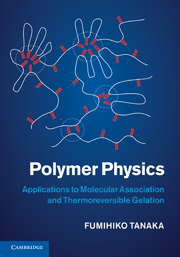Book contents
- Frontmatter
- Contents
- Preface
- 1 Statistical properties of polymer chains
- 2 Polymer solutions
- 3 Classical theory of gelation
- 4 Elasticity of polymer networks
- 5 Associating polymer solutions and thermoreversible gelation
- 6 Nongelling associating polymers
- 7 Thermoreversible gelation
- 8 Structure of polymer networks
- 9 Rheology of thermoreversible gels
- 10 Some important thermoreversible gels
- Index
- References
1 - Statistical properties of polymer chains
Published online by Cambridge University Press: 16 May 2011
- Frontmatter
- Contents
- Preface
- 1 Statistical properties of polymer chains
- 2 Polymer solutions
- 3 Classical theory of gelation
- 4 Elasticity of polymer networks
- 5 Associating polymer solutions and thermoreversible gelation
- 6 Nongelling associating polymers
- 7 Thermoreversible gelation
- 8 Structure of polymer networks
- 9 Rheology of thermoreversible gels
- 10 Some important thermoreversible gels
- Index
- References
Summary
This chapter reviews the elementary statistical properties of a single polymer chain in solvents of different nature. Starting with the ideal random coil conformation and its tension–elongation relation, the excluded-volume effect is introduced to study the swelling and collapse of a random coil. We then focus on the conformational transition of a polymer chain by hydrogen bonding. Coil–helix transition by the intramolecular hydrogen bonding between neighboring monomers, hydration of a polymer chain in aqueous media, and competition in hydrogen bonding in the mixed solvents are detailed.
Conformation of polymers
Internal coordinates of a polymer chain and its hindered rotation
The complete set of space coordinates which specifies the conformation of a polymer in three-dimensional space is called its internal coordinates. To study the positions of the carbon atoms along the linear chain of a polymer, let us consider three contiguous atoms -C-C-C- along the chain (gray circles in Figure 1.1). Because they are connected by covalent bonds, the length l of a bond is fixed at l = 0.154 nm, and the angle θ between the successive bonds is fixed at θ = 70.53° (tetrahedral angle with cosθ = 1/3). The bond to the fourth carbon atom, however, can rotate around the axis of the second bond although its length and angle are fixed. Such freedom of rotational motion is called the internal rotation of the polymer chain [1–5].
- Type
- Chapter
- Information
- Polymer PhysicsApplications to Molecular Association and Thermoreversible Gelation, pp. 1 - 45Publisher: Cambridge University PressPrint publication year: 2011



